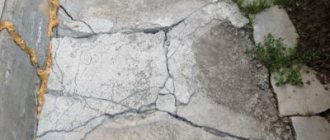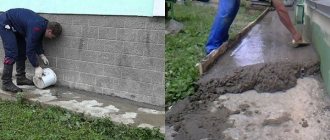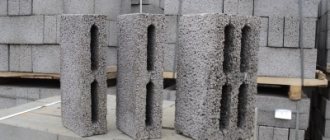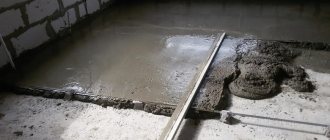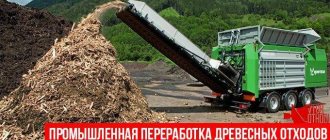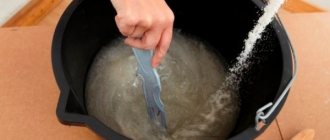Greetings, my friends!
I’ll make a short introduction and let’s go back to the summer of 2015. At that time, I came up with the “Barberry” plan for a large-scale pouring of a concrete blind area :) Since the scope of the planned work is quite serious, I thought about purchasing a concrete mixer.
My choice fell on an inexpensive, but as it turned out, very high-quality stirrer - Kraton 180. It worked for three years. I can’t say that I was exploited mercilessly, but I had to work:
- installation of blind area
- pouring the foundation
- installation of curbs
- floor screed
- filled the floors in the dog enclosure
In May 2022, I started building an outdoor brick toilet. While pouring the floor slab, the concrete mixer hummed, crunched and stopped. So, I was faced with the question of replacing the bearings in the Kraton concrete mixer .
Since I have no experience in repairing concrete mixers, I called the experts. The service announced a price of 3,000 rubles, citing the fact that the drum on the Kraton is not collapsible. After thinking a little, I decided that I would change the bearing myself.
How to disassemble a concrete mixer?
Repairing or replacing some spare parts will require almost complete disassembly of the concrete mixer. Using the example of bearing repair, let's look at how to disassemble a concrete mixer:
- The pear is turned over and, using a key, the fastening bolt connecting the shaft to the traverse is removed;
- If the shaft sits firmly in the yoke, screw in the bolt without the washer. This will minimize the risk of thread damage;
- The shaft is carefully knocked out with a tool that fits the diameter, and the pear is removed from the traverse;
- The pear support is disassembled by unscrewing the bolts;
- The shaft with bearings is removed, and then installed on any support and knocked out of the bearing with light pops;
- The bearings are renewed and the assembly of the concrete mixer begins;
- The support is attached to the pear;
- The bolts are installed in their place and tightened tightly with a wrench;
- The pear is placed back on the traverse, which is first lowered. The shaft with the pear is mounted on top;
- The shaft is shrinked into the landing zone of the traverse;
- The mounting bolts are tightened.
If bearing repairs are carried out correctly, the concrete mixer will successfully continue its service.
turns and stops, stock video
Other videos from the same categories
Pile of rubble close-up
Broken pipe, water supply, pipe repair, metal and polypropylene pipes
Modern production of aluminum plates. Beautiful drilling process
A steel drill drills a hole in a wooden board.A variety of carpentry tools and plumbing tools close-up. Carpentry work
Metal mesh background
Gear-t9
An operator controls a forklift while sitting behind the wheel, driving past shelves with goods in a warehouse.
Mixing concrete plaster using a slow panning motion
Abstract animation of rotating engine gears surrounded by red, neon waves, industrial concept. Spinning
A builder cuts metal with a special torch. Protective gloves
Builders building a house at sunset, top view
Preparing for construction on the house site
Aerial view of large sea farms on the high seas in the tropics. Marine farming concept
Cutting sheet metal using plasma cutting.
Repair Tips
Beko washing machines have some design features, thanks to which the unit can be easily disassembled:
- to change bearings, it is not necessary to remove the tank;
- To remove the drum, it will be enough to dismantle the front part of the tank.
Before disconnecting the wires, it is worth recording the initial information, for example, in a photo. This way you can easily return them to their place. The screw connection that holds the pulley must not be removed. Experts advise repairing the Beko washing machine only for simple breakdowns.
- Replacement of a damaged part or assembly.
- Removing blockages.
- Cleaning the filter.
- Replacement of the pump, heating element.
- Checking and replacing the intake valve.
For details on bearing replacement, see below.
Frequent breakdowns
A concrete mixer is a device whose repair is very simple.
. Mostly they fail due to wear of overloaded elements or simply due to improper use. The busiest parts, as a rule, are the drive elements. Often, repairing a concrete mixer requires spare parts such as gears or bearings. They take on a large load, especially if the loading mode and speed limit are violated.
Gears usually become unusable due to improper use of the device. Unfortunately, many owners of concrete mixers are convinced that the mechanism of this equipment does not need frequent lubrication, but this is a big misconception. Indeed, during operation, the load on the engine constantly increases, since the main components of the concrete mixture, which are cement and sand, tend to stick to the gear teeth, harden on them and remain for a long time. As a result, friction increases and the metal begins to wear out quickly. Lubrication is designed to reduce friction and stress on the engine.
DIY repair
You can restore the functionality of the concrete mixer yourself or with the involvement of specialists from a repair organization. To complete the task, you will need the ability to work with the listed tools and compliance with safety requirements.
A malfunction can occur both during operation and when the mechanism is turned on. During the operation of the concrete mixer, some parts, especially consumables, wear out and cause the mechanism to fail. The most significant failure is the destruction of the bearings and rotation transmission unit.
Repair Tips
When choosing new parts to repair your washing machine, make sure they are of quality and match the model of your equipment. Parts of unknown origin may lead to repeated repairs. Before installing a new part, inspect its seat - it should be free of dirt and lime deposits. If any are present, they must be removed so that the new part fits as tightly as possible. This will avoid misalignments and incorrect operation.
Disassemble the machine carefully, without making sudden movements, so as not to accidentally damage important parts and connections of the structure.
Repair of ATLANT washing machines is presented in the video below.
Replace the pulley and bearings
To replace the pulley, you need to completely disassemble the concrete mixer.
This work, unlike those described, is more painstaking and will require skill and time. First, remove the motor box, which is located on the concrete mixer, and the belt - this way you will reach the pulley. It is made of plastic. Therefore, it is logical that over time the pulley hole will become rounded and it will not be able to rotate the shaft.
There is a “plus” to this - you will fully appreciate the condition of the bearings. If there are distortions or jams, they will also have to be replaced. Then all that remains is to collect everything and return the concrete mixer to its previous state.
Pulley check
This component is made of plastic. The pulley is located on a round shaft and is milled on one side. The problem is rotation on the shaft. That is, the motor is running, the pulley is rotating, and the shaft is standing still.
The cover is removed from the motor housing, as is the case when changing a belt. After removing the belt, remove the pulley. It is in a relaxed state, but you cannot remove it yet.
The fact is that a stopper ring is attached to the rear end of the box. Until the box and engine are removed, you won't be able to get the belt and pulley.
Unscrew all bolts and nuts. With their help, the box is attached to the frame. Then remove the box and pulley. As a result, only the shaft is available. The stopper ring is unclenched and removed.
If you have done the work of removing the box, check at the same time the condition of the bearings. Manually rotate the shaft several revolutions. If it moves freely and easily, reassemble all the parts in the opposite direction.
If the shaft rotates unevenly, if something prevents it from moving freely, look at the bearings. You may have to replace these parts.
Symptoms of a problem
Sometimes it can be difficult to determine which specific part of the concrete mixer is damaged and what exactly needs repair. And the table will help determine the breakdown:
- The motor runs and hums, but the concrete mixer drum does not start;
- The belt itself comes off.
- The concrete mixer is not spinning fast enough;
- Slow start of the concrete mixer;
- The alarming sound of the engine is humming instead of buzzing.
In practice, the breakdown of a concrete mixer and its subsequent repair is not a very common phenomenon. And most often the concrete mixer stops working due to a broken control circuit. For example, due to the launch, which is carried out directly, and the power button is ignored. This leads to failure of the motor thermal relay. Due to the increase in temperature of the winding, the insulation is destroyed, the concrete mixer breaks down, and there is a need for repair.
Repair of a concrete mixer: possible malfunctions and methods for eliminating them
Any builder strives to acquire this equipment, but without knowing the operating principle of a concrete mixer, he faces a number of problems. It doesn’t want to start, it starts to buzz, and other similar troubles can await an inexperienced worker. In this article we will look at how to overcome all the difficulties and learn how to make repairs so that the concrete mixer can continue to work for a long time and reliably.
Replacing a bearing on a concrete mixer with a collapsible drum - work procedure
Optimix and Sicoma concrete mixers are mainly used with collapsible drums.
Disassembling the drum
- First you need to remove the drum. To do this, turn it over with the traverse facing up. Use a wrench to unscrew the drum mounting bolt. We remove the washer and engraver. Screw the bolt into place. Place a wooden spacer and knock with a hammer and knock the shaft out of the traverse. We remove the drum.
- After removing the drum, unscrew the mounting bolts, first filling them with WD. If you can’t unscrew them, then cut them off with a grinder.
3. We knock the shaft out of the grooves with a pipe. Using a puller, remove the old bearings. If a puller is not available, then you can use a vice, clamp the shaft in it and knock down the bearings with gentle blows.
Drum assembly
- So, we clean the shaft and seat from dirt. Carefully press the bearings using a wooden spacer. It is strictly forbidden to knock on the bearing race.
- The shaft with installed bearings is installed in the lower part of the support. We put on the top part and screw everything into place. When tightening, the nuts may turn - ask friends or family for help.
- To reduce moisture ingress into the bearings, it is recommended to apply sealant to the junction of the support and the drum.
- We put the drum on the traverse and secure it with a clamping nut.
As you can see, even a schoolchild can change the bearings in a concrete mixer with a collapsible drum. If nothing is clear, then watch the video.
How to repair a starter
You will know that the button is broken when the device turns off immediately after the button is released. That is, when you press it, the unit works normally, and when you release it, the electric motor stops.
This kind of malfunction is not complicated, but, unfortunately, it happens quite often.
The button is a magnetic starter, quite convenient and safe to use. When there is a power outage, the start button opens. In the event of an unexpected electrical appearance, the concrete mixer will not turn on on its own, which will protect you from injury.
Causes of malfunctions
Before you start repairing a concrete mixer, you need to determine what exactly is broken in it. Among the most common problems are:
- The concrete mixer does not start (it turns off after starting). Such a nuisance can happen for several reasons: the start button is faulty; the power cable is damaged; the most dangerous is that the electric motor burns out.
- Loud motor noise and no drum rotation. Most likely, the cause of such a breakdown is in the unit that transmits rotation; the belt may have stretched or it may fly off because the pulley teeth are dirty. The breakdown is quite common and can occur due to too frequent overloads.
- The device hums, but the drum does not spin. Most likely the capacitor, which is located in the wall of the electric drive, under its box, has failed. After replacing it with a similar one, the problem should be eliminated.
- Engine overheating. A very common problem with electric stirrers. It can be triggered by the following negative factors: overload; impacts, falls or sudden shocks of the device; improper storage; during operation, the air temperature did not correspond to that required for the concrete mixer (indicated in the passport); the winding or its insulation is damaged; the bearing has collapsed.
- Rotate the drum in the opposite direction. Most likely there was an electrical failure.
The difference between forced and gravity type concrete mixers: their advantages and disadvantages
According to the mixing method, all concrete mixers can be divided into two groups - with gravitational mixing and with forced mixing.
Gravity type
You've probably seen this type of mixer - they are much more widespread than forced ones. As you might guess, the principle of their operation is based on gravity. Mixing takes place in a drum rotating around its axis, and this axis is not located vertically, but at a certain angle (sometimes even horizontally). The components of the future mixture, having reached their highest point, fall down under the influence of gravity, due to which they are mixed. Such concrete mixers are cheaper and easier to operate than forced ones, but their mixing quality is somewhat lower.
Forced type
In concrete mixers with forced mixing, the working container remains stationary during operation of the apparatus - the blades located in it rotate. This method of mixing is much more effective, as a result of which the mixture quickly achieves a homogeneous consistency.
However, they are not without their drawbacks: firstly, a high price, secondly, more complex, and therefore more expensive, repairs in the event of a breakdown, and they are easier to disable than gravity ones, because they are intended only to work with fine-grained components.
Work order
Replacing the bearing of a gravity concrete mixer is not a very complicated process and consists of two stages.
Disassembly
The purpose of this step is to remove the old bearings:
We turn the container of the concrete mixer over so that the traverse is on top of the structure. Using a wrench, unscrew the bolt securing the concrete mixer shaft to the traverse. We remove the washer and groover, screw this bolt into the shaft again (to avoid damaging the thread). Using a spacer of a suitable diameter, use gentle blows to knock the shaft out of the traverse and disconnect the drum from the frame. Remove the adjusting washers from the shaft.
Attention! The loss of even one shim will disrupt the correct contact of the main gear with the ring gear, which can lead to excessive load on the engine, overheating and failure
- Disconnect the support from the container. As practice shows, the nuts of the fastening bolts, which are located on the outside of the drum, rust heavily, since the production of concrete mixture occurs using water and high humidity. To make it easier to unscrew the mounting bolts, we use a “liquid wrench” (WD40), which we spray onto the bolts. After 5-10 minutes we try to unscrew them. If this method does not help, cut off the old nuts with a grinder.
- We separate the bowl support from the drum and separate it into two component parts (in which the recesses are made - seats for bearings). To do this, use a pipe (or spacer) of a suitable diameter to knock out the shaft along with the bearings from the halves of the drum support.
- We remove the old bearings from the shaft using a three-jaw puller or a vice.
Assembly
The purpose of this stage is to install new bearings:
- We clean the shaft from dirt and rust with gasoline or solvent, after which we press new bearings onto it using a puller. If it is absent, this operation is carried out by carefully tapping the inner races of the bearings evenly around the circumference through a piece of pipe or a wooden block.
- Carefully drive the shaft with pressed bearings into the lower half of the support. After that, we put the second half on the upper bearing. We pre-lubricate the seats with lithol (this will simplify the crimping process).
- After this, we attach the support with the pressed shaft to the container using bolts, washers, screws and nuts. To prevent the bolts from turning inside the drum, they must be held with a wrench. Therefore, to carry out this operation you will need an assistant. Before installing the support, we apply a layer of silicone sealant along its entire perimeter at the points of contact with the drum (to increase the tightness and protect the bearings from moisture).
- We place adjustment washers on the shaft, then insert it into the hole in the traverse and fix it with a clamping bolt through the washer and the groover.
After this, we test turn on the concrete mixer without load to check whether the engagement of the drive gear with the ring is sufficient.
How to change a bearing on a household concrete mixer video:
Symptoms of a problem
Sometimes it is not immediately possible to identify a fault in the bearing assembly of an automatic washing machine. Often the user notices a problem when it becomes glaring.
Determining possible bearing failure is actually not difficult. You just need to listen to the operation of the washing machine. It often happens that a unit located, for example, in a bathroom, being loaded and running, works there in absolute solitude. At this time, the housewife can be busy with other household chores or immerse herself in watching her favorite TV series. Actually, this is why the automatic washing machine was invented. However, this home assistant remains a machine, and therefore, monitoring its condition is necessary.
The car is humming
The first warning sign of bearing wear may be an unusual sound that occurs when the washing machine operates. It can be especially pronounced when switching to spin mode, when engine speeds become highest.
The machine may suddenly make noise, completely unexpectedly - it is important to immediately pay attention to this
Such noise will not go away on its own, the machine will creak more and more clearly, and when switching to other modes, the contacting metal parts will begin to rattle. She will make more and more noise, declaring that the bearing has broken.
It is important not to ignore this noise, because the bearing has already begun to collapse
If you wait until the bearing has completely collapsed, the drum may jam, and the machine will receive very serious damage to several important components at once. True, even earlier the rubber seal will collapse, and water will begin to flow into the bearing, and then onto the floor. The leakage is very dangerous; a short circuit may occur in the electric motor.
Strong vibration
Gradually, vibration of the machine is added to the noise during the transition to another mode, for example, from rinsing to spinning. Excessive vibration at high speeds can lead to noticeable movements of the machine on a flat floor.
Spin does not work
The bearings are pressed in at the factory, and parts of the destroyed assembly will not simply come out of the seat by themselves. The engine receives additional resistance from a worn-out unit, as a result of which in the spin mode, where high speeds are provided, the machine may stop working. Operation of the unit in this condition is unacceptable.
Drum swings when loading
It is not always possible to recognize a malfunction immediately. To do this, you can check the drum play by shaking it in a horizontal plane. You can also notice play during loading - a drum with worn bearings will sway quite noticeably on the shock absorbers and springs.
Preparation of materials and tools
If it is possible to diagnose wear of the bearing assembly, it is necessary to immediately begin preparations for its replacement. As a rule, it will not be possible to do this at home without preparation, since not all the necessary tools will be at hand. It is not worth starting the procedure for replacing bearings without appropriate preparation; this will not speed up the process at all.
To work you need to select all the necessary tools:
- pliers;
- wrenches (open-end and socket);
- hammer;
- rubber mallet;
- a metal pin or chisel of small diameter (about 0.5 cm);
- crosshead screwdriver;
- slotted screwdriver;
- screwdriver with replaceable tips.
In addition to tools, you should prepare silicone sealant and special lubricant for the bearings and oil seal. As a last resort, if it was not possible to obtain a special lubricant, you can use the thick lubricant “Litol”. However, its efficiency is several times less, and it will gradually begin to leak water, which will inevitably lead to rapid wear of the newly installed bearings. To remove rust and dirt, you may need WD-40 or something similar.
Well, of course, you need to purchase the appropriate replacement parts in advance. It is better to immediately buy a set consisting of large and small bearings and a rubber seal. To do this, you don’t have to go to the store with the old parts removed from the machine; you can simply rewrite the markings indicating the model of your particular washing machine.
In specialized stores they can select a bearing of the appropriate size even from a different model of washing machine. Often different manufacturers install these parts of the same type. The most important characteristics of bearings are dimensions: internal diameter, external diameter and width. These values can be determined using the number indicated on the bearing.
Prevention measures
After repairing the concrete mixer and eliminating any malfunctions in one or another part of it (or better yet, immediately after purchasing the equipment), you should try to use the device in the future so that similar or any other problems do not arise again.
To do this, you need to follow a few simple requirements:
- Do not allow the control unit to come into contact with water.
- It is necessary to fill the drum with concrete components no more than 4/5 of the specified norm.
- Make sure that the voltage in the network to which the concrete mixer is connected does not exceed the maximum permissible. The manufacturer usually reports what voltage the device can withstand.
- All working units need to be inspected periodically, and after preparing the concrete mixture, they should be cleaned of adhering sand and cement.
- Do not forget that the shaft and gears need regular lubrication.
If you try to follow all these not very complicated rules, then the concrete mixer will last quite a long time and you won’t have to think about its repair throughout its entire service life.
If the device fails, then even someone who is not a great specialist in the field of construction can quickly repair concrete mixers with their own hands. It is enough just to determine which element has become unusable and replace it with a new one.
If your concrete mixer breaks down during construction, you can repair it yourself.
Breakdown of these units can be prevented through proper operation of the concrete mixer.
Causes and signs of failure
During intensive use of a concrete mixer, one of the 2 bearings most often breaks. Signs of its failure:
- extraneous noise in the drum, similar to crunching or crackling;
- sudden stop of the drum even at low loads;
- slow start of the unit;
- noticeable play when shaking the bowl manually.
Please note: a concrete mixer needs to change 2 bearings at once, even if the second one is fully operational.
There are several reasons why a part fails prematurely. The most common is overloading the unit. When the permissible load on the equipment increases (all standards are specified in the technical documentation), the bearing assembly breaks down much faster.
Other less common causes include moisture, sand, small stones or other foreign objects getting under the bearing housing. Also, the unit fails due to a previously installed low-quality part.
To prevent premature bearing failure, you need to clean the unit from any remaining adhering concrete mass after each use, and also ensure that moisture, dust and sand do not get into the mechanism. There is no need to overload the equipment and try to make more concrete mixture at one time than is allowed in the manufacturer’s recommendations. It is important to properly care for the mixer and perform timely maintenance.
We replace worn bearings in the concrete mixer SBR_ 132_A
Signs of worn bearings in concrete mixers are as follows:
— the rotation of the unit is normal, fast, but it is not possible to start immediately;
— the sound of a running engine is not quite normal, it hums unpleasantly.
Don't worry about having to purchase a new concrete mixer. The problem is the failure of the bearings mounted on the shaft. There are two of them. This is the shaft on which the pulley and gear are installed.
The bearings used here are number 203. Their price is low, so replacing the parts will be inexpensive.
It was described above how to dismantle the gearbox and engine if it is necessary to replace the pulley. When replacing bearings we do the same.
The pear in the concrete mixer is also removed. To do this, you will need to use a gas and open-end (thirteen) wrenches. Using a three-legged puller will help a lot.
Use a gas wrench to unscrew the locknut and the nut that secures the bulb. Use the thirteenth open-end wrench to unscrew the side stopper bolt. Is the pear still there? Use a puller and press out the shaft. Now the pear should definitely fall out. Don't lose small parts like shims.
The next step is to remove the retaining ring, which is located near the gear. If you do not have the correct size puller, use force to dislodge the shaft.
The frame will spring back. To prevent this from happening, a wooden block is placed against the shaft and it is knocked out. Bearings along with it.
You have taken out a shaft with two bearings hanging on it, you also have a sleeve identical in size to the external size of the bearings, and a small spacer sleeve.
The key is pulled out, a special puller is installed on the side where the gear was previously located. Now remove the bearings by applying pressure to the shaft.
We replace worn parts with new bearings. Be sure to take care to lubricate the shaft. After thorough lubrication, also use a puller to put on new parts.
There is another option for fitting parts without a puller. Select a tube the size of the shaft, tap along the inner diameter and hammer into the desired location.
Collection occurs in reverse order.
What are the problems with the drive gear?
You often use a concrete mixer, it rotates and works. To ensure a long service life, make sure that the drive gear is lubricated before each work shift. Litol is perfect for this. There should be a lot of lubricant.
Place the neck of the bowl down, turn on the concrete mixer, and process the crowns, also using lithol.
If you do not do this regularly, the gear will fail.
To replace a worn gear, the bowl is not always removed. Take the tenth key and unscrew the fixing bolt. The washer is removed, now you can remove the gear. Be careful not to lose the small key.
Place a new part and assemble all parts in reverse order.
Design features and operating principle
A concrete mixer is a device that allows you to get a concrete mixture ready for use. This device mixes components with water in certain proportions. In everyday life, a gravity-type design is usually used.
It consists of seven main elements:
The work is performed in the following order:
- The drum is fixed at a certain angle.
- Water is poured into it.
- Then the main components are loaded.
- All you have to do is press the start button and the mixing will begin.
If, with the correct actions, the concrete mixer does not start, it means there is a defect or malfunction.
Before disassembling the concrete mixer and starting repairs, you must make sure that the product’s warranty period has already expired. If the warranty is valid, it is better to take the equipment back to the store where it was purchased and report any problems that have arisen: most likely, you will be able to get a completely new concrete mixer.
Concrete mixer device
If problems arise with the performance of this electrical unit, there is no need to immediately send it to an expensive service center or workshop. It is quite possible to disassemble, make the necessary replacement, and reassemble the concrete mixer at home with your own hands. You will need a little patience, basic repair skills, and inexpensive, common tools.
The purpose of concrete mixers is to obtain a concrete mixture that is immediately ready for construction work. All components of the concrete solution are mixed, water is also added in strict proportions.
The concrete mixer brand_SBR_ 132_A is a cyclic gravitational type. The size of the aggregate in this model is no more than forty millimeters. Finding spare parts for such concrete mixers is not a problem.
The device consists of several main parts:
- A drum containing blades. This is the main container in which all components for concrete are mixed. Special blades are designed for better mixing of ingredients.
- An important component is the presence of a traverse. The drum is attached to it.
- A mechanism that enables rotation. This is a flywheel. With its help, the angle in which the drum is located is established. The angle for loading the ingredients of the concrete mixture and the angle for unloading the prepared concrete are also selected. All this is done manually.
- A clamp that secures the position of the drum in the required plane.
- Electric motor. The movement of a concrete mixer depends on its power.
- The presence of a running gear in this unit is mandatory. Consists of a frame.
Breakdowns in concrete mixers happen in different ways. Let's look at some of them.
Preparation for repair
Typically, repairing a concrete mixer comes down to replacing a failed part. The first thing you have to do is determine which part was damaged, and then purchase exactly the same new one somewhere. The concrete mixer is repaired by the owner himself, without seeking help from specialists, since this does not require any special skills or tools.
Every owner can easily find everything needed for repairs on his farm.
The list of tools that you cannot do without when repairing a concrete mixer includes:
However, this list is only conditional, since much in the repair of concrete mixers depends on the nature of the breakdown.
The electrical part of the concrete mixer is an electric motor, a magnetic starter, as well as a start button and a starting capacitor. Most often, the engine does not start after pressing the button due to problems either with the starter or with the button itself.
To check whether the starter is working properly, use a multimeter. In this case, it is necessary to determine the integrity of the coil and adjacent contacts. If the coil burns out, then it should be replaced, preferably together with the starter, since the contacts also wear out significantly.
The functionality of the start button can also be checked with a multimeter. And if, as a result of the check, it turns out that the button is faulty, then it should also be replaced.
To repair your concrete mixer, you may have to remove the drum. To do this, you will need a wrench, the size of which depends on the size of the drum and the model of the concrete mixer. Most often, a 13 mm wrench is used, but it is possible that you will need some other one. The key is needed to unscrew the fastening nut, locknut and fixing bolt, which is located on the side.
If a bearing needs to be replaced, the following steps must be followed:
Belt
The motor works, tries, buzzes cheerfully (obviously without signs of tearing or biting), but the stirrer does not turn. Let's fix it!
A belt is a consumable item, just like in a car. The SBR-132A is equipped with a 5РJ 610 (five-ribbed belt 610 mm long). Replacing it is simple. We remove the protective cover and disconnect the contacts from the starter so that it does not interfere. Slightly loosen the two bolts that are on the back side and secure the motor. Using your hands, lift the motor up a little and remove the belt. This is if it is still standing there))) Usually, if it buzzes and does not turn, then the stirrer has removed or broken the belt for you, and there is no need to remove anything. It puts on without much effort, first it clings to the small pulley that is on the motor. Then it is pulled onto the top one. Then you need to tighten the belt. It's better to do this with a friend. A friend presses on the box, and you tighten the two bolts that you loosened before removing the belt.
How to replace a bearing?
You can install a new bearing instead of a faulty one yourself. However, you should read the instructions in advance to properly prepare the device for replacement. You should start by preparing all the necessary tools, as well as new parts, including oil seals.
After this, you need to disconnect the washing unit from the electrical network. The device should then be installed so that the rear panel is accessible. You need to unscrew all fasteners on it, and then remove the entire panel. You can then remove the detergent dispenser. Using a screwdriver, unscrew the electronic control unit and set it aside.
Once the lock is released, you can remove the remaining parts and then remove the front of the panel. To loosen the clamp, remove all interfering elements. Then you can dismantle the counterweight and heating element
However, it is important to remember how the main nodes are located. You can even take photos of them to do this.
Replacing the bearing begins with unscrewing and removing the pulley. After this, the shaft is knocked out using a rubber hammer. Next, you need to unscrew the bolts that connect the parts of the tank. Now that the bearing is visible, it needs to be knocked out. A chisel is used for this.
At the last stage, the seals are removed. After which the place for the new part is prepared. First, it is cleaned and then lubricated with a special product. Now you can assemble everything, but only in reverse order.
How to fix startup problems?
The button is located on the casing, which is held on by four self-tapping screws. When making repairs, you will need a Phillips screwdriver to unscrew them. Remove the lid with gentle movements. There are five wires under the cover. They are connected to the starter.
Carefully disconnect all wires. The button also unscrews. It is attached with two self-tapping screws.
Disassemble it to clean all the contacts located in the middle of the starter. Using a thin-tip screwdriver, press the latches located on both ends of the button.
The front element is removed. There is a small space visible on the leg. The leg has a curved shape, remember the location so that all the parts are placed exactly in their places. Otherwise, the unit will not work. At the back you will see black carbon deposits formed. It was because of this that the launch failed. Using fine sandpaper, clean it. At the same time, clean the core in contact with carbon deposits. Reassemble the starter in reverse order.
